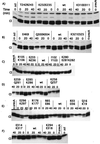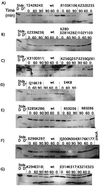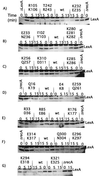Analysis of Escherichia coli RecA interactions with LexA, lambda CI, and UmuD by site-directed mutagenesis of recA
- PMID: 10692372
- PMCID: PMC94464
- DOI: 10.1128/JB.182.6.1659-1670.2000
Analysis of Escherichia coli RecA interactions with LexA, lambda CI, and UmuD by site-directed mutagenesis of recA
Abstract
An early event in the induction of the SOS system of Escherichia coli is RecA-mediated cleavage of the LexA repressor. RecA acts indirectly as a coprotease to stimulate repressor self-cleavage, presumably by forming a complex with LexA. How complex formation leads to cleavage is not known. As an approach to this question, it would be desirable to identify the protein-protein interaction sites on each protein. It was previously proposed that LexA and other cleavable substrates, such as phage lambda CI repressor and E. coli UmuD, bind to a cleft located between two RecA monomers in the crystal structure. To test this model, and to map the interface between RecA and its substrates, we carried out alanine-scanning mutagenesis of RecA. Twenty double mutations were made, and cells carrying them were characterized for RecA-dependent repair functions and for coprotease activity towards LexA, lambda CI, and UmuD. One mutation in the cleft region had partial defects in cleavage of CI and (as expected from previous data) of UmuD. Two mutations in the cleft region conferred constitutive cleavage towards CI but not towards LexA or UmuD. By contrast, no mutations in the cleft region or elsewhere in RecA were found to specifically impair the cleavage of LexA. Our data are consistent with binding of CI and UmuD to the cleft between two RecA monomers but do not provide support for the model in which LexA binds in this cleft.
Figures






Similar articles
-
Differential cleavage of LexA and UmuD mediated by recA Pro67 mutants: implications for common LexA and UmuD binding sites on RecA.J Mol Biol. 1998 Feb 20;276(2):405-15. doi: 10.1006/jmbi.1997.1531. J Mol Biol. 1998. PMID: 9512712
-
New recA mutations that dissociate the various RecA protein activities in Escherichia coli provide evidence for an additional role for RecA protein in UV mutagenesis.J Bacteriol. 1989 May;171(5):2415-23. doi: 10.1128/jb.171.5.2415-2423.1989. J Bacteriol. 1989. PMID: 2651400 Free PMC article.
-
RecA protein-dependent cleavage of UmuD protein and SOS mutagenesis.Proc Natl Acad Sci U S A. 1988 Mar;85(6):1806-10. doi: 10.1073/pnas.85.6.1806. Proc Natl Acad Sci U S A. 1988. PMID: 3126496 Free PMC article.
-
Locations of functional domains in the RecA protein. Overlap of domains and regulation of activities.Eur J Biochem. 1996 Nov 15;242(1):20-8. doi: 10.1111/j.1432-1033.1996.0020r.x. Eur J Biochem. 1996. PMID: 8954148 Review.
-
Role of Escherichia coli RecA protein in SOS induction and post-replication repair.Biochimie. 1985 Mar-Apr;67(3-4):353-6. doi: 10.1016/s0300-9084(85)80079-1. Biochimie. 1985. PMID: 3899189 Review.
Cited by
-
Bacteriophage lambda: Early pioneer and still relevant.Virology. 2015 May;479-480:310-30. doi: 10.1016/j.virol.2015.02.010. Epub 2015 Mar 3. Virology. 2015. PMID: 25742714 Free PMC article. Review.
-
Sequence tolerance of the phage lambda PRM promoter: implications for evolution of gene regulatory circuitry.J Bacteriol. 2004 Dec;186(23):7988-99. doi: 10.1128/JB.186.23.7988-7999.2004. J Bacteriol. 2004. PMID: 15547271 Free PMC article.
-
mobileOG-db: a Manually Curated Database of Protein Families Mediating the Life Cycle of Bacterial Mobile Genetic Elements.Appl Environ Microbiol. 2022 Sep 22;88(18):e0099122. doi: 10.1128/aem.00991-22. Epub 2022 Aug 29. Appl Environ Microbiol. 2022. PMID: 36036594 Free PMC article.
-
RecT Affects Prophage Lifestyle and Host Core Cellular Processes in Pseudomonas aeruginosa.Appl Environ Microbiol. 2022 Sep 22;88(18):e0106822. doi: 10.1128/aem.01068-22. Epub 2022 Sep 8. Appl Environ Microbiol. 2022. PMID: 36073944 Free PMC article.
-
SOS regulation of the type III secretion system of enteropathogenic Escherichia coli.J Bacteriol. 2007 Apr;189(7):2863-72. doi: 10.1128/JB.01859-06. Epub 2007 Jan 19. J Bacteriol. 2007. PMID: 17237173 Free PMC article.
References
-
- Backman K, Ptashne M. Maximizing gene expression on a plasmid using recombination in vitro. Cell. 1978;13:65–71. - PubMed
-
- Bailone A, Levine A, Devoret R. Inactivation of prophage λ repressor in vivo. J Mol Biol. 1979;131:553–572. - PubMed
-
- Bolivar F, Rodriguez R L, Greene P J, Betlach M C, Heyneker H L, Boyer H W, Crosa J H, Falkow S. Construction and characterization of new cloning vehicles. II. A multipurpose cloning system. Gene. 1977;2:95–113. - PubMed
-
- Churchward G, Belin D, Nagamine Y. A pSC101-derived plasmid which shows no sequence homology to other commonly used cloning vectors. Gene. 1984;31:165–171. - PubMed
Publication types
MeSH terms
Substances
Grants and funding
LinkOut - more resources
Full Text Sources
Molecular Biology Databases
Research Materials

